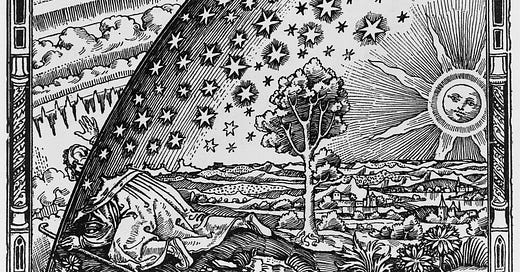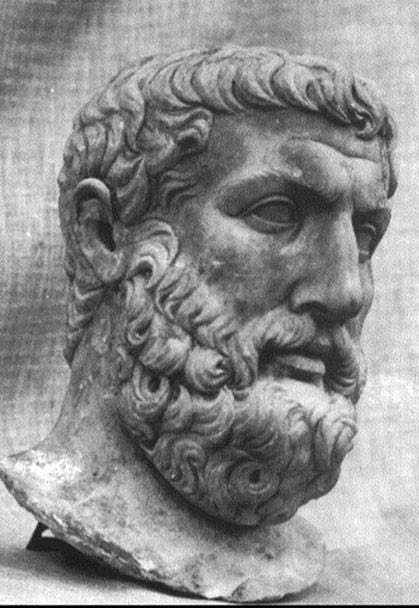Flammarion engraving, Paris 1888.
Stay, illusion!1
As the fibrillation of the entire fabric of our cosmos ensues relentlessly, unabatedly, and unassailably under the karmic momentum of a cyclical chronology2 that the blood-drenched linear time bandits of the Abrahamic warlord-asshole-worshipping lemmings cannot shoehorn into their ersatz eschatology: more and more the concept of the cosmos as a construct has impinged itself into our social symposiums.
First, let us dispense with all the scientists who have been overwriting spirituality with their materialism since the creation of The Royal Society (1660) as the control system of what we are told is real, from Isaac Newton to Stephen Hawking. One really needs to read Francis Bacon’s New Atlantis (1626) to get the template for the Royal Society. The stranded shipmen on the New Atlantis ‘utopia’ (‘no-place’ in Greek) watch as dozens of silk-clad boys carry a richly garbed scientist-priest on a palanquin, whose silk slippers never touch the ground, to the adoration of the crowds lining the street.3 Later, after kissing the priestly ring, they are told of all the animal torture and human psychological torture, etc, that these scientists are doing for the good of humanity. Bacon (who patently did not write the plays attributed to Shakespeare) was all aboard with this. As Leibniz said of Bacon: “He wants to put Nature on the rack and strip her of her secrets.” And thus science (which used to mean ‘knowledge’) went from knowledge about the world, to knowledge of how to control it.
So when some physicist talks about giant computers like Deep Think running reality through you, there is a certain truth to it, as you feel watching The Matrix films. But they are stuck, one, in trying to retain a physicalist underpinning of human experience, which is impossible, no matter how bloody sophisticated your ‘meat-brain’ theory is, and two, they are circumscribed by a computer model of the human brain. They can only relate to binary firing of neurons, off or on, like computer coding. Computers were modeled on the brain, and now the brain is modeled on computers, in a recursive loop de loop that evades human experience.
The language of this discussion is often problematic, yet it is all we have to sing across the void.
The word cosmos itself was stultified into scientific stasis by Carl Sagan’s “billions and billions and billions of stars” out there, demeaning and demoralizing human experience, reducing our soul to an infinitesimal speck in vast nihilistic space. Originally, as any make-up artist or hairdresser knows, cosmos meant ‘a beautiful, orderly arrangement’. You can get a degree in cosmetology and know more than scientists. The ancients originally saw that the cosmos referred to how our world of experience is beautifully organized and constructed, not how it permanently hangs in the sky.
Plato in the Timaeus claimed that the fashioner of this world, the demiurgos, did the best job possible, given the less than perfect materials at hand. It seems only warped wood was available at Home Despot.
If the word cosmos now is tainted with scientism, what of other options like simulation, simulacrum, construct or illusion? The Matrix Trilogy beginning in 1999, famously depicted a massive computer-generated program simulating life within the crania of trapped podsters in gooey cells. The basic inaccuracy of the films (based on what we are proposing), is that there is a real physical independently-existing world outside the matrix, a dreary machine-ruled surface with a very brown underground neolithic revival city called, ahem, Zion. So, a simulation by definition, has to be a simulation of something, and the deal the ancients understood is, there is nothing else beyond it.
When I hear ‘construct’ my mind goes to something like the film The Truman Show, again, where the character lives within a stage set, but eventually rows to the limit of the set to find a ‘real world’ beyond it. Still, it brings in the vital aspect of him being tricked, essential to understanding the preSocratic Greek philosophers Empedocles and Parmenides.
Simulacrum gets us a little closer. Going back to Jean Baudrillard, it would be a generated reality not based on an original, but having enough correlates to make it a type of reality, a hyperreality. Disneyland being the prime example. “It is no longer a question of imitation, nor duplication, nor even parody. It is a question of substituting the signs of the real for the real.”4 (The Simulacra is an under-appreciated book of Philip K. Dick’s, by the way.)
What do we mean by ‘independently-existing’? Simply, that a world exists in physicality outside of human experience. And it sure seems that way. You go out, you come home, and your house is still there. Usually. But the mystic perception belies this. The seer has had the experience of this reality generated through the sensorium. The senses, which are our body of experience, are the means through which the illusion of a real world are run. And equally intractable is the sense of a real self, an ego, a personality that is equally real and solid.
Thus, if there is no solid world out there, then it follows the divine needs us to experience the cosmos through our sensorium. Since there is no world out there for the divine to experience, we are all there is. We are the “Eyes of the World”, as the song goes.
Maybe though, in the dire stillness of a meditation, or an entheogenic cracking, or even a gift from an unknown benefactor, you have come to the uncanny realization that your sense of self is a joke, that there is a far realer ‘you’ that is covered in the sticky molasses of self-deception. Or that there is a trace of insubstantiality holding every idea of a wall together.
Simple example: once, during a decade of regular Yogic meditation, I was working as an estate gardener, planting tulip bulbs. As I put the trowel in the soil, instead of a hole, the ground dissolved into infinitude, there was nothing actually below my feet, never was. As it says in the Vedic Purusha Sukta, every step creates the Earth. That is the only Earth there is, constructed for you.
Parmenides
Parmenides (born circa 515 BC) of Velia in Italy, wrote a poem that initiates the sacred western tradition in many ways. The best book on this, and likely the most important ‘spiritual’ book of the 21st century is Peter Kingsley’s Reality (using his translations here). To be painfully reductive, Parmenides writes of a journey—certainly a real one for him—to the underworld where he is welcomed by Thea, the goddess, who most certainly is Persephone. She gives him a download about being, (on in Greek), as “birthless, it’s also deathless and whole and of a single kind and unmoving—neither is it incomplete”, “now, altogether, one, holding to itself”, “there is no dividing it because it’s all alike . . . Full of being . . . Everything is continuous with everything . . . It stays just the same in the same unaltered state, lies by itself on its own and so remains constantly where it is.”
This being is the only reality. All is in one place, we cannot go anywhere, we are everywhere, we are nowhere. The goddess then goes on to describe the world of deception, which is the world we take as real. Her gift to Parmenides is the first knowledge of things like the tropic of Cancer and Capricorn, the Earth as a sphere, “so that nobody among mortals will ever manage, in practical judgement, to ride on past you.” In other words, because as a heroic initiate he has made the effort to go into the Greek form of meditation, hesychia, stillness, practicing incubation, she rewards him not only with a vision of being, what is the only reality, and, with intel on how to best navigate (metis) the illusion we inhabit. And the illusion we are, as selves.
To understand Plato you have to understand his struggle with the clear precise absolute radicality of Parmenides. His attempt of “parricide of father Parmenides” via equivocating rationalism is a vital story we will get to another time.
A couple of lines from Kingsley’s Reality before we move on to Empedocles.
The situation is perfectly simple. Either we are trapped in an illusion or we are not. And there is no way to extricate ourselves from the illusion, none at all—only the illusion that there is. . . We assume there has to be a let-out clause: reckon there must be relative degrees of deception, a kind of hierarchy to it all . . . But there are no relative degrees. There is only deception . . . Understanding the illusion only comes after the understanding of reality, not before. The knowledge of many things, of absolutely anything, comes after the knowledge of the one and only thing: not the other way around. Until we have the experience of reality, in all its stillness, we are still lost. . . There is no deception apart from reality, and no reality apart from deception. The deception is what is real.
Empedocles
Empedocles’ (born circa 492 BC) writings are especially important for us as our illusion splinters via strife. In fact, for him, there are two great cyclic pumps running the illusion: Love—Aphrodite—and Strife. Aphrodite is the weaver of the deception of a real cosmos, and love attaches us to all the deceptive elements that seem so real, from pizza to partners. Love is binding. Love of self, love of your neighbor, and all the lovely new age platitudes we arm ourselves with. These are the inextricable webs of delusion, especially including the personality we are addicted to.
But Strife is freeing. And it sure looks like an epic cycle of strife is upon us. To ride that freedom train is painful, as the bindings are ripped from us to become who we are, navigators of a divine illusion. From Empedocles poem:
Just like when painters work on intricately ornamented pictures—professionals, well skilled in their craft through metis, who take special paints of various colors in their hands and mix them with either greater harmony or less to produce shapes and forms resembling anything or everything, creating trees and men and women and animals and bird and water-nourished fish and long-lived gods who have the highest dignity and honors—just so, don’t let deception overthrow the seat of your awareness and make you believe that whatever you see, all thoise countless numbers of mortal beings around you, has any other source [than Aphrodite’s deception]. But know this, and know it clearly, once you have heard these words spoken by a god.
In other words, to see through the deception fully, sensorially, in conscious awareness, you have to become a god. To be mortal is to be trapped in the ‘painter picture’ thinking it is real.
And the way to out-trick the trick is to become absolute stillness, so that the delusion forgets you because you no longer interact with it, and when it disappears, and you along with it, what remains is the true ground of being, reality itself.
Bhagavad Gita
Indian writings of roughly the same time period of these Greeks discuss the illusion, Maya, who is a deity. Similarly, the only possibility is having the vision of what is real, where you cannot abide, and then to navigate the illusion. Here is a quote from my book Katabatic Wind:
Throughout ancient, and persisting in some of contemporary India, māyā is the illusory nature of reality, as well as the power of that illusion,5 and considered a living deity. The modern consensus encompasses the range of more or less illusory and correct views of some preexisting reality—depending on the various cable news show dictates—but this is not so. It is reality itself that is the illusion, and there is no real world ‘out there’ existing apart from the illusion. There is only māyā. ‘All the world’s a stage’; ‘Life’s a walking shadow’.
From the mystic perspective, there is no question that the cosmos is an illusion. The only question left, then, is one of navigation. And navigational facility comes through knowledge of māyā.
What is not māyā is not of this world. Kṛṣṇa teaches in the Bhagavad Gita:
Īśvara (highest vision, lord, pure consciousness) abides
in the heart center of all beings, Arjuna, through māyā causing all beings to move, attached to a machine (yantra). (18.61)Truly divine is māyā, composed of the guṇas6 through me, and difficult to negotiate.
Those who take refuge in me penetrate this māyā.Katabatic Wind, 20167
Thank you all for your attention!
Steve
PS: Also, highly highly recommended book on the deception at the heart of religions and current reality is enna reitort’s Krivda.
PPS: One of my favorite illusions:
1 Hamlet, speaking to the ghost of his father, trying to ascertain if he is real. Act 1.
2 See Jason Breshears astonishingly detailed rework of human chronology through
https://archaix.com , and his books.
3 The scene plays like a gay wet dream. There are extant letters from his mother warning about the Portuguese sailor boys taking over his house. At least partly why Bacon got a time out in the London Tower.
4 Baudrillard, The Precession of Simulacra.
5 Śakti is the female aspect of that power, flowing through the central column of the body, and lila is that same power of manifestation and illusion, seen as divine play, or in the case of Hamlet, a play.
6 The three guṇas are an integral aspect of Yoga philosophy, and can only be lightly sketched here. They divide all of experience into sattva (light, wisdom, purity, peace), rajas (activity, passion) and tamas (indolence, density, ignorance). They are all apparent in every experience, in differing degrees. Although the tendency is to extol the virtues of sattva, you need rajas’ energy to simply move, and cannot hammer in a nail without the density of tamas. The goal for the Yoga practitioner is to see life, experience, through the movement of these guṇas, which helps to remove egoic agency from life’s activity.
7 By the author: https://logosophiabooks.com/book/katabatic-wind/ available until the end of things.







